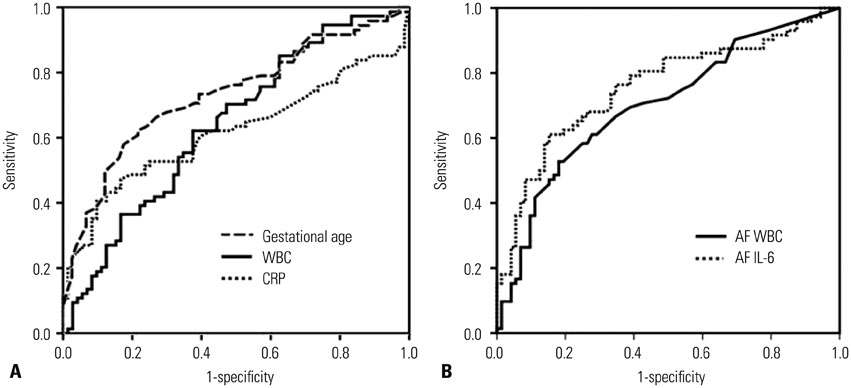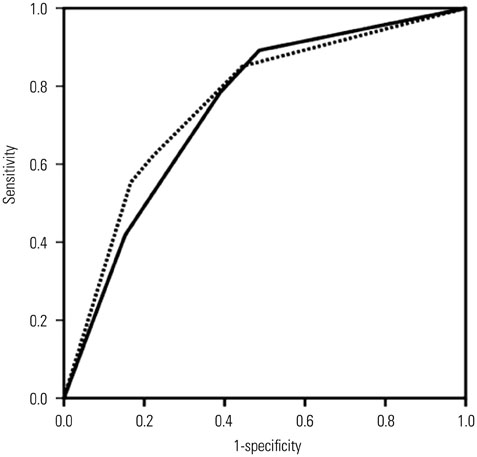Yonsei Med J.
2016 Mar;57(2):461-468. 10.3349/ymj.2016.57.2.461.
Non-Invasive Prediction of Histologic Chorioamnionitis in Women with Preterm Premature Rupture of Membranes
- Affiliations
-
- 1Department of Obstetrics and Gynecology, Seoul National University College of Medicine, Seoul, Korea.
- 2Department of Obstetrics and Gynecology, Seoul National University College of Medicine, Seoul National University Bundang Hospital, Seongnam, Korea. pkh0419@snubh.org
- 3Department of Obstetrics and Gynecology, Seoul Metropolitan Government Seoul National University Boramae Medical Center, Seoul, Korea.
- KMID: 2374054
- DOI: http://doi.org/10.3349/ymj.2016.57.2.461
Abstract
- PURPOSE
To develop a model based on non-invasive clinical and ultrasonographic parameters for predicting the likelihood of subsequent histologic chorioamnionitis in women with preterm premature rupture of membranes (PPROM) and to determine whether the inclusion of invasive test results improves the predictive value of the model.
MATERIALS AND METHODS
This retrospective cohort study included 146 consecutive women presenting with PPROM (20-33 weeks). Transvaginal ultrasonographic assessment of cervical length was performed. Maternal serum C-reactive protein (CRP) levels and white blood cell (WBC) counts were measured after amniocentesis. Amniotic fluid (AF) obtained by amniocentesis was cultured, and interleukin-6 (IL-6) levels and WBC counts were determined. The primary outcome measure was histologic chorioamnionitis.
RESULTS
Risk scores based on serum CRP concentrations and gestational age (model 1) were calculated for each patient. The model was shown to have adequate goodness of fit and an area under the receiver operating characteristic curve (AUC) of 0.742. When including AF test results (e.g., AF IL-6 levels) in model 1, serum CRP concentrations were found to be insignificant, and thus, were excluded from model 2, comprising AF IL-6 levels and gestational age. No significant difference in AUC was found between models 1 and 2.
CONCLUSION
For women with PPROM, the newly developed model incorporating non-invasive parameters (serum CRP and gestational age) was moderately predictive of histologic chorioamnionitis. The inclusion of invasive test results added no predictive information to the model in this setting.
Keyword
MeSH Terms
-
Adult
*Amniocentesis
Amniotic Fluid/*cytology/microbiology
C-Reactive Protein/*metabolism
Chorioamnionitis/blood/*diagnosis/metabolism
Cohort Studies
Female
Fetal Membranes, Premature Rupture/*blood
*Gestational Age
Humans
Infant, Newborn
Interleukin-6/blood
Leukocyte Count
Predictive Value of Tests
Pregnancy
ROC Curve
Retrospective Studies
Sensitivity and Specificity
C-Reactive Protein
Interleukin-6
Figure
Reference
-
1. Cobo T, Kacerovsky M, Palacio M, Hornychova H, Hougaard DM, Skogstrand K, et al. A prediction model of histological chorioamnionitis and funisitis in preterm prelabor rupture of membranes: analyses of multiple proteins in the amniotic fluid. J Matern Fetal Neonatal Med. 2012; 25:1995–2001.
Article2. Park KH, Kim SN, Oh KJ, Lee SY, Jeong EH, Ryu A. Noninvasive prediction of intra-amniotic infection and/or inflammation in preterm premature rupture of membranes. Reprod Sci. 2012; 19:658–665.
Article3. Elimian A, Verma U, Beneck D, Cipriano R, Visintainer P, Tejani N. Histologic chorioamnionitis, antenatal steroids, and perinatal outcomes. Obstet Gynecol. 2000; 96:333–336.
Article4. Yoon BH, Romero R, Kim CJ, Jun JK, Gomez R, Choi JH, et al. Amniotic fluid interleukin-6: a sensitive test for antenatal diagnosis of acute inflammatory lesions of preterm placenta and prediction of perinatal morbidity. Am J Obstet Gynecol. 1995; 172:960–970.
Article5. Oh KJ, Park KH, Kim SN, Jeong EH, Lee SY, Yoon HY. Predictive value of intra-amniotic and serum markers for inflammatory lesions of preterm placenta. Placenta. 2011; 32:732–736.
Article6. Jacobsson B. Infectious and inflammatory mechanisms in preterm birth and cerebral palsy. Eur J Obstet Gynecol Reprod Biol. 2004; 115:159–160.
Article7. van de Laar R, van der Ham DP, Oei SG, Willekes C, Weiner CP, Mol BW. Accuracy of C-reactive protein determination in predicting chorioamnionitis and neonatal infection in pregnant women with premature rupture of membranes: a systematic review. Eur J Obstet Gynecol Reprod Biol. 2009; 147:124–129.
Article8. Yoon BH, Jun JK, Park KH, Syn HC, Gomez R, Romero R. Serum C-reactive protein, white blood cell count, and amniotic fluid white blood cell count in women with preterm premature rupture of membranes. Obstet Gynecol. 1996; 88:1034–1040.
Article9. Gonçalves LF, Chaiworapongsa T, Romero R. Intrauterine infection and prematurity. Ment Retard Dev Disabil Res Rev. 2002; 8:3–13.
Article10. Park KH, Lee SY, Kim SN, Jeong EH, Oh KJ, Ryu A. Prediction of imminent preterm delivery in women with preterm premature rupture of membranes. J Perinat Med. 2011; 40:151–157.
Article11. Lee SY, Park KH, Jeong EH, Oh KJ, Ryu A, Kim A. Intra-amniotic infection/inflammation as a risk factor for subsequent ruptured membranes after clinically indicated amniocentesis in preterm labor. J Korean Med Sci. 2013; 28:1226–1232.
Article12. Park KH. Transvaginal ultrasonographic cervical measurement in predicting failed labor induction and cesarean delivery for failure to progress in nulliparous women. J Korean Med Sci. 2007; 22:722–727.
Article13. Gibbs RS, Blanco JD, St Clair PJ, Castaneda YS. Quantitative bacteriology of amniotic fluid from women with clinical intraamniotic infection at term. J Infect Dis. 1982; 145:1–8.
Article14. Jobe AH, Bancalari E. Bronchopulmonary dysplasia. Am J Respir Crit Care Med. 2001; 163:1723–1729.
Article15. Dulay AT, Buhimschi IA, Zhao G, Luo G, Abdel-Razeq S, Cackovic M, et al. Nucleated red blood cells are a direct response to mediators of inflammation in newborns with early-onset neonatal sepsis. Am J Obstet Gynecol. 2008; 198:426.e1–426.e9.
Article16. Yoon BH, Jun JK, Romero R, Park KH, Gomez R, Choi JH, et al. Amniotic fluid inflammatory cytokines (interleukin-6, interleukin-1beta, and tumor necrosis factor-alpha), neonatal brain white matter lesions, and cerebral palsy. Am J Obstet Gynecol. 1997; 177:19–26.
Article17. Richter D, Bartmann P, Pohlandt F. Prevention of necrotizing enterocolitis in extremely low birth weight infants by IgG feeding? Eur J Pediatr. 1998; 157:924–925.
Article18. Perkins NJ, Schisterman EF. The inconsistency of "optimal" cutpoints obtained using two criteria based on the receiver operating characteristic curve. Am J Epidemiol. 2006; 163:670–675.
Article19. Hanley JA, McNeil BJ. A method of comparing the areas under receiver operating characteristic curves derived from the same cases. Radiology. 1983; 148:839–843.
Article20. Jun JK, Yoon BH, Romero R, Kim M, Moon JB, Ki SH, et al. Interleukin 6 determinations in cervical fluid have diagnostic and prognostic value in preterm premature rupture of membranes. Am J Obstet Gynecol. 2000; 183:868–873.
Article21. Fisk NM, Fysh J, Child AG, Gatenby PA, Jeffery H, Bradfield AH. Is C-reactive protein really useful in preterm premature rupture of the membranes? Br J Obstet Gynaecol. 1987; 94:1159–1164.
Article22. Rizzo G, Capponi A, Vlachopoulou A, Angelini E, Grassi C, Romanini C. Ultrasonographic assessment of the uterine cervix and interleukin-8 concentrations in cervical secretions predict intrauterine infection in patients with preterm labor and intact membranes. Ultrasound Obstet Gynecol. 1998; 12:86–92.
Article23. Hillier SL, Witkin SS, Krohn MA, Watts DH, Kiviat NB, Eschenbach DA. The relationship of amniotic fluid cytokines and preterm delivery, amniotic fluid infection, histologic chorioamnionitis, and chorioamnion infection. Obstet Gynecol. 1993; 81:941–948.24. Gire C, Faggianelli P, Nicaise C, Shojai R, Fiori A, Chau C, et al. Ultrasonographic evaluation of cervical length in pregnancies complicated by preterm premature rupture of membranes. Ultrasound Obstet Gynecol. 2002; 19:565–569.
Article25. Ghidini A, Salafia CM, Minior VK. Lack of relationship between histologic chorioamnionitis and duration of the latency period in preterm rupture of membranes. J Matern Fetal Med. 1998; 7:238–242.
Article26. Ovalle A, Martínez MA, Kakarieka E, Gómez R, Rubio R, Valderrama O, et al. Antibiotic administration in patients with preterm premature rupture of membranes reduces the rate of histological chorioamnionitis: a prospective, randomized, controlled study. J Matern Fetal Neonatal Med. 2002; 12:35–41.
Article27. Hutzal CE, Boyle EM, Kenyon SL, Nash JV, Winsor S, Taylor DJ, et al. Use of antibiotics for the treatment of preterm parturition and prevention of neonatal morbidity: a metaanalysis. Am J Obstet Gynecol. 2008; 199:620.e1–620.e8.
Article28. Ohlsson A, Wang E. An analysis of antenatal tests to detect infection in preterm premature rupture of the membranes. Am J Obstet Gynecol. 1990; 162:809–818.
Article29. Ramsey PS, Lieman JM, Brumfield CG, Carlo W. Chorioamnionitis increases neonatal morbidity in pregnancies complicated by preterm premature rupture of membranes. Am J Obstet Gynecol. 2005; 192:1162–1166.
Article30. Royston P, Altman DG, Sauerbrei W. Dichotomizing continuous predictors in multiple regression: a bad idea. Stat Med. 2006; 25:127–141.
Article
- Full Text Links
- Actions
-
Cited
- CITED
-
- Close
- Share
- Similar articles
-
- A comparative study of the diagnostic value of amniotic fluid interleukin-6 and culture for the antenatal diagnosis of intrauterine infection and prediction of perinatal morbidity in patients with preterm premature rupture of membranes
- The relationship between amniotic fluid white blood cell count and the presence and severity of acute placental inflammation in preterm premature rupture of membrane
- The Association with Amniotic Fluid Interleukin-6 and Histologic Chorioamnionitis in Patients with Preterm Labor and Intact Membranes
- Neonatal Brain Damage Following Prolonged Latency after Preterm Premature Rupture of Membranes
- Prenatal Diagnosis of Intrauterine Infection and Prediction of Neonatal Morbidity by Maternal Serum C-Reactive Protein in Patients with Preterm Premature Rupture of Membranes



